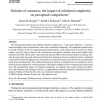15 search results - page 2 / 3 » Quasi-bicliques: Complexity and Binding Pairs |
JCC
2011
12 years 10 months ago
2011
: Docking is one of the most commonly used techniques in drug design. It is used for both identifying correct poses of a ligand in the binding site of a protein as well as for the ...
BMCBI
2008
13 years 7 months ago
2008
Background: Structure-based computational methods are needed to help identify and characterize protein-protein complexes and their function. For individual proteins, the most succ...
BMCBI
2006
13 years 7 months ago
2006
Background: Many dimeric protein complexes bind cooperatively to families of bipartite nucleic acid sequence elements, which consist of pairs of conserved half-site sequences sepa...
BMCBI
2010
13 years 7 months ago
2010
Background: Phosphorylation events direct the flow of signals and metabolites along cellular protein networks. Current annotations of kinase-substrate binding events are far from ...
COGSCI
2004
13 years 7 months ago
2004
The fundamental relations that underlie cognitive comparisons--"same" and "different"--can be demultiple levels of abstraction, which vary in relational comple...

